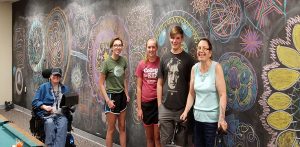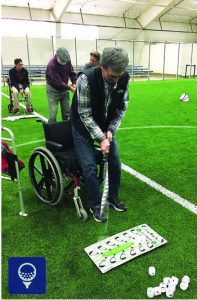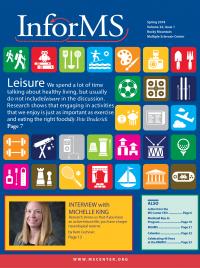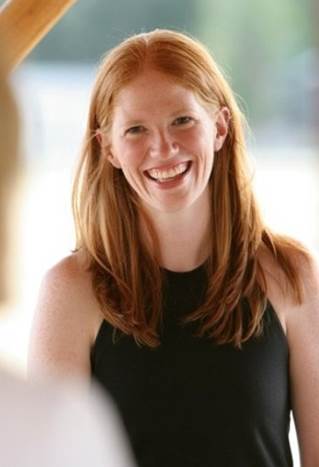InforMS: What does the research tell us about the importance of leisure for health and wellness?
 MK: Research shows us that if you have an active leisure life, you have a larger neurological reserve, helping to build a more resilient brain. Approaching something through a leisure route can cause neurons to fire in a different way than a typical task and helps keep your brain healthier longer.. Your brain is more capable and resilient to weather life’s constant battles if you’re regularly engaged in something you enjoy.
MK: Research shows us that if you have an active leisure life, you have a larger neurological reserve, helping to build a more resilient brain. Approaching something through a leisure route can cause neurons to fire in a different way than a typical task and helps keep your brain healthier longer.. Your brain is more capable and resilient to weather life’s constant battles if you’re regularly engaged in something you enjoy.
Research studies have also looked retrospectively at the person’s life upon diagnosis with an illness or disease. There’s a strong correlation between people who didn’t engage in leisure activities and the severity of dementia and Alzheimer’s disease. Studies of aging individuals also show that if individuals’ identities were entirely wrapped up in work or family, their health is more likely to decline faster upon retirement because they aren’t able to cope.
And, fundamentally, leisure activities help to reduce overall stress for all of us. Doing something you enjoy can reduce your stress and improve your mood. With that reduction of stress and negativity, you’re less likely to have overall health problems – a healthier heart lower blood pressure.
Leisure fights depression. Depression is the worst enemy of any disease. The more depressed you are, the less likely you are to engage in activities that are health benefitting. Staying engaged, keeping depression at bay, and finding ways to have those connections that we all need.
For example, research shows us that laughter actually reduces blood pressure. And in a study conducted by Matthew Zawadski, a psychology professor at University of California, Merced, they found that people who took part in leisure activities reported that they were 34% less stressed and 18% less sad.
InforMS: What is the biggest misconception about leisure?
 MK: People often think that leisure is only supplementary to eating right and exercising. They think, “Yeah sure, if I have time, I’ll try to squeeze that in.” And most of us are trained from an early age to think that leisure is “The Fun Stuff” that you do if and only if you get your job and tasks done. We’re often engrained with the notion that we should feel guilty if we’re not on task or “productive.” However, the fact is that it is critical to incorporate leisure into your life to promote overall wellness in your life. Indeed, engaging in activities that you enjoy is just as important as exercise and eating healthy foods.
MK: People often think that leisure is only supplementary to eating right and exercising. They think, “Yeah sure, if I have time, I’ll try to squeeze that in.” And most of us are trained from an early age to think that leisure is “The Fun Stuff” that you do if and only if you get your job and tasks done. We’re often engrained with the notion that we should feel guilty if we’re not on task or “productive.” However, the fact is that it is critical to incorporate leisure into your life to promote overall wellness in your life. Indeed, engaging in activities that you enjoy is just as important as exercise and eating healthy foods.
InforMS: What are the challenges of incorporating leisure in your life?
MK: Finding ways to modify leisure activities that work for them and fit into their schedule. It’s actually the same with incorporating other wellness strategies. People say “I don’t have time to exercise” and “I don’t have time to cook healthier.” You have time to do all of those things, but it requires going about them in a scale that works for your schedule and daily life. Most people don’t think about that scalability of leisure. People tend to think of the “grand escapes,” like flying off for a week in Hawaii, but most of us can’t afford a week in Hawaii on a regular basis. So then folks think that they don’t have access to leisure. But, the good news is that leisure comes in many different forms and can be scaled in ways that are do-able and approachable.
InforMS: What are some examples of leisure that people can incorporate into their everyday lives, especially when living with a chronic disease like MS?
MK: Many people find it’s helpful to think about some of the more routine parts of their life – like sitting in the waiting room at the doctor’s office, or waiting in the pick-up line at your child’s school. In these moments, it can be tempting to sit and look at social media on your phone or fret over what is about to happen during their doctor’s appointment. These waiting times can be tedious, so it can be quite helpful to incorporate an activity that you enjoy doing.
Instead of worrying or ruminating about problems while you’re waiting, think about an activity that you enjoy and whether you could incorporate it into those times. Could you bring a book along and read, or listen to an audio book with headphones? Or, you could bring a sketch pad to journal or color. If you enjoy knitting, you could bring your yarn and needles to continue that project you’ve wanted to finish up. By focusing on an activity that you enjoy, you’re giving your mind an opportunity to engage during an otherwise unused (and sometimes unpleasant) period of time.
InforMS: The types of activities that you’ve outlined are all fairly individual approaches. Is it important to find a balance between individual and social leisure activities?
MK: It really depends on the individual – both your personality and your lifestyle. Some people are social all day at work, so maybe they prefer a more solitary activity. And some people work all day in a silo, so they may seek out group interaction for their leisure pursuits.
If you are interested in incorporating socializing into activities you enjoy, there are some simple ways to start doing that. For example, you could have family game night once a month or every Friday evening. Or you could schedule times to go walk laps at your local recreation center and make a point to say hello when you pass people – and through that simple step you can start to create those friendships. Even swimming laps in a lap lane, people start to become friends and they realize they have more in common than they knew. The important thing is to find an activity that is fun for you, that fits your personality, and then scale it to what works best for your life.
InforMS: If someone is unsure about what will work best for them, how can they start identifying what activities they might enjoy?
MK: It can be helpful to start thinking about what you’ve enjoyed throughout your life. You can also think about what you’re seeing other people do and think about whether it might be something you’d like to try. (Check out the examples of leisure activities in the side bar – attached.)
Then you can begin looking for options and tools to help get you started. If you have challenges with mobility or cognition, there are so many technological resources these days that can help you adapt most any activity to meet your needs. By googling “adaptive knitting” or “adaptive painting,” for an example, you will find lots of unique resources. Or if you visit your local craft store or recreation center and say, “I’d like to try this, but I have difficulty doing x, y, or z,” they will be able to give you specific ways and/or tools to adapt that activity or if they don’t know, they will often know where to reach out to find out.
The willingness to ask is a real challenge that people experience. You’re putting yourself out there and you’re becoming more vulnerable. It’s important to recognize that your vulnerability leads to your empowerment and life satisfaction and helps overcome feelings of depression, loneliness, or feeling stuck.
InforMS: What is therapeutic recreation and how is it connected with the concept of leisure?
MK: Therapeutic recreation uses treatment, education, and recreation to help people with illnesses, disabilities, and other conditions to develop and use their leisure in ways that enhance their health, functional abilities, independence and quality of life. For me, therapeutic recreation is taking a leisure approach to changing something that is something that is life-limiting.
Therapeutic recreation starts with the individual. We start by thinking about “What can I do?” “What do I enjoy doing?” Therapeutic recreation takes those “can do’s” and finds the things that we can modify to work for that individual. For example, if you enjoy painting and you’ve only got the use of one hand and the paper is sliding it’s finding the anti-slip mats or taping your paper down while you paint. Or if knitting is more up your alley, you can use a loom with an anti-slip pad. People who enjoy leather work can use a clamp to hold their work in place.
If cooking or baking is your passion, there are ways to make it less tiring if you are battling fatigue. Many people find that sitting down to do prep work like chopping really helps them to conserve energy.
InforMS: You are the director of RMMSC’s King Adult Day Enrichment Program which is an innovative and community-based day program for younger adults with MS, brain injury and other neurological conditions. How does KADEP utilize therapeutic recreation?
MK: KADEP provides a dynamic array of classes and activities and other services designed to enhance the physical, emotional, cognitive and social wellbeing of each participant. KADEP strives to maximize the functioning, independence, wellness and life enjoyment of all who attend. Therapeutic recreation and promotion of leisure activities is at the root of all that we do.
Everything that we do is about clients’ choice and clients’ interests. We’re empowering individuals to choose and sample different activities. And because we offer so many program options, clients are getting to choose and sample so many things to figure out where their niche is, and then continue to engage in those things with support and adaptation.
Our research at KADEP has shown that clients, even if their disability may increase over time, perceive an overall improved quality of life. Clients talk about KADEP as a family. They have a community where they can be themselves. People don’t question why they need something done differently. People encourage each other to ask for that adaptation and they encourage each other to try different things.
The whole structure of KADEP is about choosing that leisure approach that makes you happy and then exploring all the different ways that you can incorporate that into your life. Our staff members educate themselves on many different approaches and ideas to keep up with our clients’ interest. Someone might say, “I heard about this craft…Have you ever done it?” From there, our staff take that enthusiasm and dive right in to learn more about it and use their creativity to shape an engaging program.
Fundamentally, leisure should add to your life in a way that is gratifying and soothing for your soul.
InforMS: What are a few examples of how you’ve seen lives impacted by infusing leisure into their lives?
MK: One of our clients, Bernie, joined us 3 years ago and wasn’t able to walk one lap around our building. At our last Multiple Summits for MS Kickoff, she walked 29 laps in just one morning. Activities that she enjoyed, like fun active games groups, adaptive sports groups, and “boot camp,” helped her get motivated and moving. She built her confidence, and she was having FUN. She realized that while walking can be a tedious thing, but if you’re walking and chatting with a friend, it can be really fun. Instead of a forced regiment, it was a fun regiment.
Another example that comes to mind occurred during a group trip to go cross country skiing. On the car ride to the ski area, one person said, “This is pointless, I can’t do it, it’s going to be over in 2 minutes, I’m going to have to sit in the van while everyone else has fun…” But, at the end of the day, that person had a huge smile on their face and they were the ones saying “You can do this, you’ve got this, you’ve got the challenge, you can meet it!”
Watching that enlightenment happen was incredibly powerful. And for weeks afterward, that individual said to me, “If you hadn’t pushed me, I would have said that’s one area of my life I can’t do, and now a new area has been opened up for me.” Trying that one activity had opened other doors for him: “Maybe I can try this, or maybe I can try that or learn about that.” Taking on challenges becomes a real gateway for people.
Another person had very limited stamina with her MS and she was struggling with walking. Two aisles into the grocery store, her fatigue would take over and she would be done. She started doing fitness groups and games and adapted sports groups – she was laughing and having fun. From there, her stamina increased and her quality of life increased. She didn’t need someone to take her to the grocery store any more or sit in the motorized cart to do. She could walk through the grocery store. And she found reasons to laugh.
Taking that one first step to ask for help or a new resource really just opens up all the things you can do.






